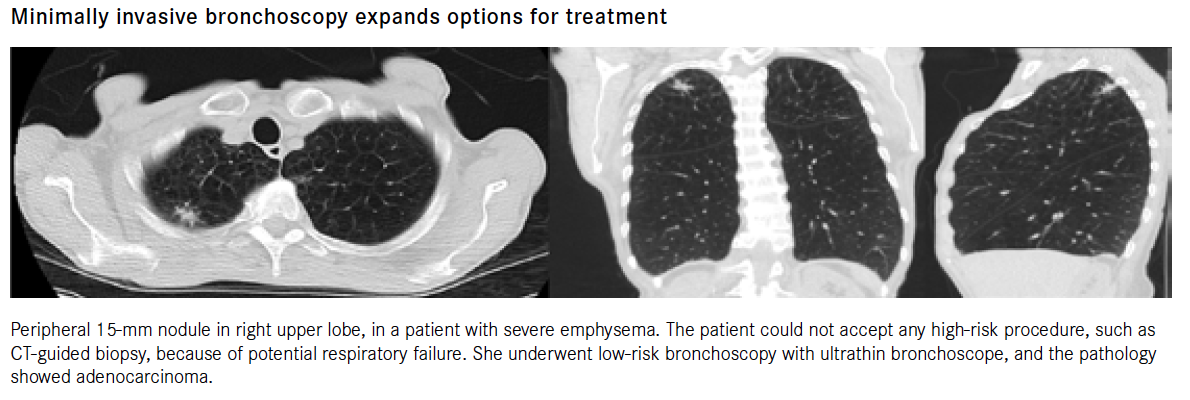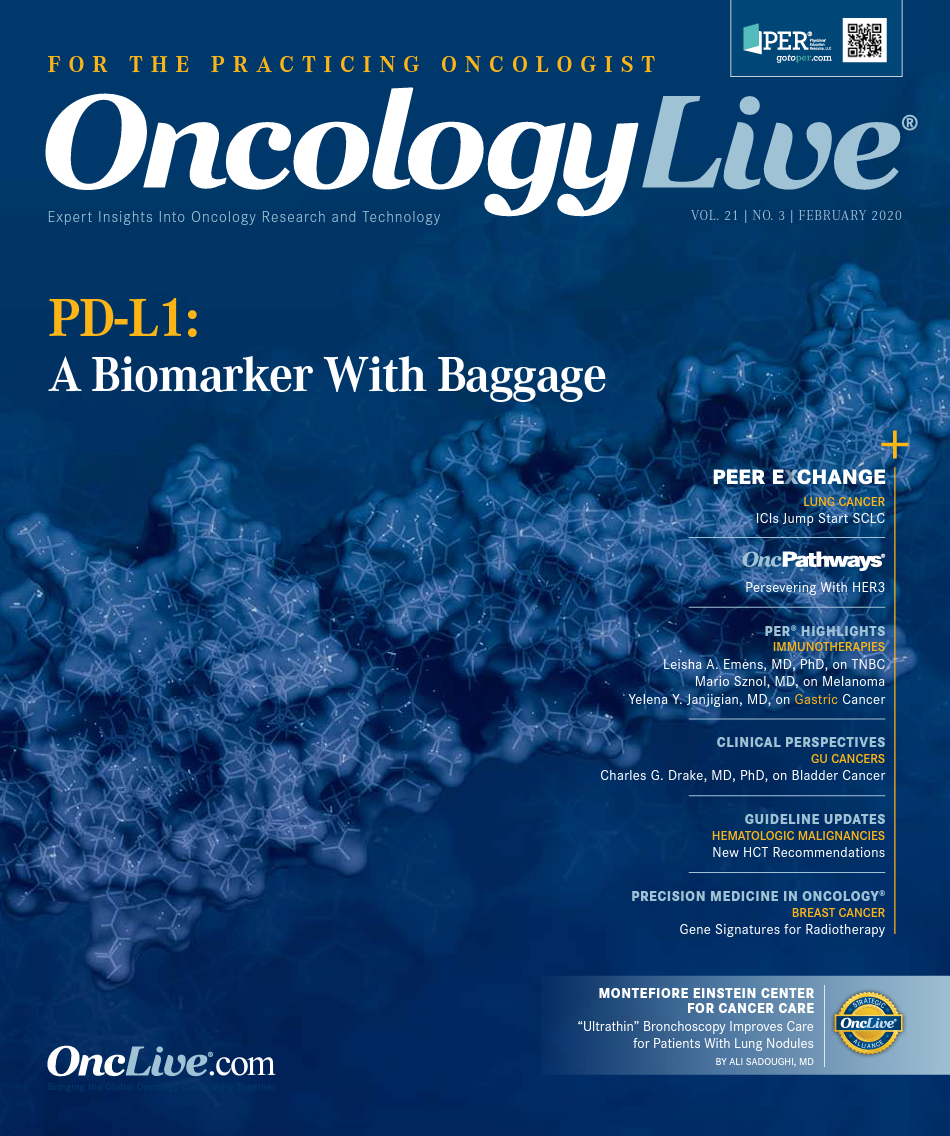"Ultrathin" Bronchoscopy Improves Care for Patients With Lung Nodules
To spare patients from surgery or other unnecessary procedures, Montefiore Einstein Center for Cancer Care developed an advanced method of bronchoscopy that provides peace of mind for individuals with lung nodules. The minimally invasive bronchoscopy provides a very safe method of biopsy, importantly at very early stages when the nodules are relatively small.

Ali Sadoughi, MD
Director of Interventional
Pulmonology and
Bronchoscopy,
Montefiore Health System,
Assistant Professor for
Pulmonary and
Critical Care, at
Albert Einstein
College of Medicine,
The Bronx
Lung nodules, which are lesions smaller than 3 cm in diameter, are highly challenging to diagnose and treat. The traditional means of diagnosis includes a CT-guided biopsy via the chest wall or a surgical biopsy. Both methods are associated with risk and discomfort for patients.1,2
However, the incidence of lung nodules is increasing, making the use of minimally invasive techniques to diagnose and treat lung diseases more important than ever. In 2010, more than 4.8 million Americans had at least 1 chest CT scan, and 1.57 million had a lung nodule identified on at least 1 of those scans; further, 63,000 received a new lung cancer diagnosis within 2 years of the CT scan.3
With implementation of low-dose CT lung cancer screening programs in clinical practice, an increase in the discovery of nodules is expected. Although results of the National Lung Screening Trial showed the benefits of low-dose helical CT scans, most notably a 20% decrease in lung cancer deaths, the downside of this comprehensive screening was a high rate of false-positive nodules (95%).4
The moment someone is told they have a lung nodule, they naturally feel a lot of anxiety. At Montefiore Einstein Center for Cancer Care in the Bronx, New York, we are committed to helping our patients get through this situation by using the safest method of diagnosis. Bronchoscopy has the lowest rate of complications among sampling modalities, but not every bronchoscopy method provides a high diagnostic yield (DY).5
To spare our patients from surgery or other unnecessary procedures, we developed an advanced method of bronchoscopy that provides peace of mind for individuals with lung nodules. Our minimally invasive bronchoscopy provides a very safe method of biopsy, importantly at very early stages when the nodules are relatively small. Many of our patients have benefited from this technology, including those who have had benign lung nodules.
Bronchoscopic Methods for Nodule Biopsies
Figure 1. (Click to Enlarge)

Other available modalities include virtual bronchoscopy, electromagnetic navigation bronchoscopy, virtual guidance SPiN-Perc technology, and technologies in development for a better DY of peripheral lung lesions. They use thin-slice CT scans for virtual airway reconstruction and provide a navigation map through the airways or chest wall to access the lung nodule.
Multiple prospective, registry, and systematic reviews have been published, each indicating variable rates of success for different modalities as well as operatordependent results. DYs among medical centers ranged from 33% to 73% in the American College of Chest Physicians Quality Improvement Registry, Evaluation, and Education (or AQuIRE) registry.7 Movement of nodules with the respiratory cycle and the variable configuration of the airway anatomy during bronchoscopy affect the DY of electromagnetic navigation procedures and are the reasons we feel traditional bronchoscopy methods fall short.8
Figure 2. (Click to Enlarge)

Ultrathin bronchoscopies with multimodal devices for peripheral pulmonary lesions are a promising method with a relatively low cost of technology acquisition. The ultrathin bronchoscope, with a 3.0-mm distal-end outer diameter and 1.7-mm working channel, could reach more distal bronchi compared with traditional bronchoscopes and provide an unprecedented visualization of the small airways (Figure 1).10
Ultrathin Bronchoscopy and R-EBUS
At Montefiore, we have had an early opportunity to use the ultrathin bronchoscope to sample small peripheral lung lesions. Since the start of the program, in late 2015, we have performed about 300 R-EBUS—guided peripheral lung lesion biopsies. We are proud to state that we have a strong success rate, finding lung nodules with real-time imaging using R-EBUS approximately 94% of the time.11 As a result of the acquisition of the ultrathin bronchoscope, our DY has increased further in the past few months. Most recently, we have offered the bronchoscopic biopsy to our patients with nodules as small as 10 mm in diameter, or about the size of a small hazelnut. Compared with other advanced navigational, robot-assisted or cone-beam CT—guided bronchoscopy technologies, this is a low-cost and comparably effective method.
We have presented the results of our R-EBUS—guided peripheral lung lesion biopsies at both national and international conferences. With this minimally invasive technique, we have been able to obtain enough tissue to make a definitive diagnosis of primary or metastatic cancer in multiple small lung lesions or reach a diagnosis of benign lesions, leading to a different route of treatment(Figure 2).12
Our latest report was presented at Chest Annual Meeting 2019, where we characterized the variables that can affect the DY of bronchoscopy. Among other findings, we noted that an irregular border in lesions 15 mm or less offers a better DY, suggestive of different access to lesions.13 We believe these results can lead to advancement of technologies for better and safer biopsies of small lung nodules.
Importantly, this technology has demonstrated the least amount of complications compared with other forms of biopsy. Montefiore serves one of the most economically vulnerable populations in the country, and our patients suffer from high rates of comorbidities, such as lung emphysema. With this in mind, we believe a low-risk procedure is desirable for our patients’ safety. Thankfully, the risk of pneumothorax has been less than 1%, and patients have experienced no major bleeding complications.
The ultrathin bronchoscope, maneuvers incredibly well in peripheral airways, providing good bronchial visibility. This also extends the outreach in peripheral small bronchi and improves the proximity of the bronchoscope tip to peripheral lesions. Further, it provides real-time confirmation of the lesion location when used with the R-EBUS probe. Using this new form of bronchoscopy, we have been able to visualize tiny peripheral airways at the level of terminal bronchioles, very close to small peripheral lung targets. Traditional bronchoscopies have never achieved this distance.
Using the ultrathin scope, Montefiore has diagnosed about 20 cases of peripheral lung nodules that were not accessible using any other form of technology. These early experiences were reported at the 2019 American Association of Bronchology and Interventional Pulmonology Conference.12
Our studies identified the need for successful peripheral airway bronchoscopy and biopsy. Fulfilling this need required better visualization of peripheral bronchi, a closer reach to targeted lesions, increased precision to obtain a concentric view of the lesion, stability of tools during repeated sampling of the target, and availability of needle biopsy, among other tools.
A new bronchoscopy platform must also be cost-effective and have a fast operator learning curve. Our study demonstrates that we might have achieved just that. Stay tuned for more investigation using this exciting technology. We look forward to sharing more stories about how individuals with lung nodules can have more minimally invasive, safer, and higher-quality diagnostic—potentially even therapeutic—procedures.
Cone-beam CT with augmented fluoroscopy combined with electromagnetic navigation bronchoscopy and 2 robot-assisted bronchoscopy systems (Monarch by Auris and Ion by Intuitive) are other methods used to increase the DY of pulmonary nodules. Although these systems represent sophisticated engineered technologies, each comes with costs and acquisition challenges. Promising findings have emerged from clinical trials; however, the effects on lung nodule DY in real-world patient populations have yet to be determined.9
The radial endobronchial ultrasound (R-EBUS) modality uses a miniaturized (1.4-mm outer diameter) rotating ultrasound probe with a wave frequency of 20 MHz that is inserted through the working channel of a flexible bronchoscope. It assists with the real-time localization of about 96% of peripheral pulmonary lesions during bronchoscopy.6





